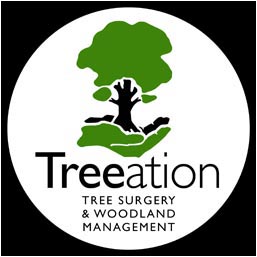Tree Surgery - GWT
Tree surgery Health & Safety works for Gloucestershire Wildlife Trust at Lower Woods Nature Reserve

Work was carried out in March 2011 on 5 large mature trees (2 ash, 3 oak) at Lower Woods Lodge, as well as on 2 other large oaks within the reserve. The requirement was to make these large trees safe, as they were located around the car park of Lower Woods which is regularly used by visitors, volunteers and employees.

Treeation undertook the work using a small team of fully qualified and experienced arborists. The work included removing large pieces of loose aerial deadwood from inside the trees' crowns, severing ivy before it became dominant, and reducing limbs that were out of balance. One of the larger ash trees had a heart-wood rotting fungus, Innotus hispidus, that can cause limb failure, so two large limbs were removed from this tree to reduce the risk.
Coronet cuts were used on some of the trees to replicate a more natural appearance similar to storm damage branch fracture. This method allows the cuts to blend into the setting of a wildlife reserve as well as adding some invaluable aerial deadwood. A coronet cut involves leaving a stub which is then cut in jagged fashion and is encouraged by Neville Fay a leading pioneer of environmental arboriculture. The term coronet cut arises from the crown like appearance of the branch stub that is cut using a chainsaw. Please read this article for more details http://www.treeworks.co.uk/downloads/8%20-
%20Coronet%20cuts%20&%20retrenchment
%20pruning%2017%20April%202003.pdf
|
|


